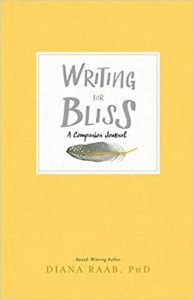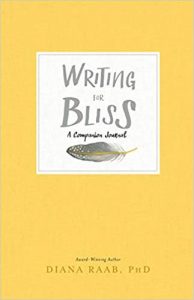Writing For Transformation And Bliss
 In late 2017, my book, Writing for Bliss: A Seven-Step Plan for telling Your Story and Transforming Your Life was published, and the response to it has been excellent. As a result, I decided to create a companion journal and this was just released on January 1st, 2019. Developed for the seasoned storyteller as well as the emerging author, this interactive journal is designed to be used in conjunction with Writing for Bliss: A Seven-Step Plan for Telling Your Story and Transforming Your Life—or as a stand-alone workbook for reflection and self-discovery.
In late 2017, my book, Writing for Bliss: A Seven-Step Plan for telling Your Story and Transforming Your Life was published, and the response to it has been excellent. As a result, I decided to create a companion journal and this was just released on January 1st, 2019. Developed for the seasoned storyteller as well as the emerging author, this interactive journal is designed to be used in conjunction with Writing for Bliss: A Seven-Step Plan for Telling Your Story and Transforming Your Life—or as a stand-alone workbook for reflection and self-discovery.
The companion journal offers writing prompts, exploratory exercises, and inspirational quotes to lead readers through the healing and transformational process as they relate the stories only they can tell. As they progress through the journal, readers will be able to:
- Discover unique, actionable writing prompts and exercises.
- Move at their own pace—navigating the landscape of their lives authentically and gently
- Identify and explore pivotal life-changing events that have led to the here-and-now.
- Heal and transform through the writing process.
Writing for Bliss: A Companion Journal speaks to the growing need for inner peace, acceptance of the self, and healing and transformation. Throughout the trials of my own journey, including ongoing struggles with cancer, a drug-addicted daughter, and a challenging relationship with her mother, I have come to realize that writing has saved my life, time and time again. I created this journal to serve as an inspirational guide for both chronicling and navigating life’s challenging times . . . and also as a path to bliss.
Transformation has to do with a dramatic change for the better in a person’s sense of wholeness and well-being. It entails becoming aware of, facing, and accepting responsibility for our thoughts and feelings. Writing is a powerful tool for going deep into yourself in this process.
The idea of writing for transformation is about setting out on a new journey for yourself. Imagine packing to visit a new land. You’d want to remain alert, mindful, and perceptive of your environment and your innermost feelings, while paying attention to and using your senses to express yourself. For example: What do you feel? What do you see? What do you hear? What do you sense? What do you smell? What touches you?
We transform when we write about our lived experiences because writing helps us make sense of those experiences and also reminds us of the lessons we’ve learned along the way. Sometimes when looking back at a life experience, it’s easier to see it in the grand universal spectrum of life, rather than as an isolated event.
Events change us, and those events that transform us the most may be thought of as pivotal or life changing. These events may involve the loss of loved ones, evolving relationships, becoming a parent and grandparent, sexual relationships, and conversations with others. Many of these subjects can lead to further exploration in our writing.
Here are some benefits of journaling for transformation:
- creates a sense of well-being
- relieves stress
- provides a container for our thoughts
- increases self-awareness
- fosters self-discovery and personal growth
- helps focus thoughts
- helps cultivate a relationship with your higher self
As in any ritual or practice, the best results when writing for bliss and transformation come about by maintaining a regular daily writing routine. The regularity will result in a deeper awareness. The deeper you go, the more transformative your experience will be. Like with everything else in life, you will get out of it what you put into it.
Writing for bliss is about writing in a way that ultimately transforms you to feel pure joy and happiness. It’s about listening to and following the messages of your heart. When writing for bliss, you’re writing your emotional truth and no one else’s. You’re not trying to please or impress anyone. You’re tapping into the real you. Perhaps you feel that external responsibilities have suppressed the real you. Writing for bliss is about returning to your true self and being set free from what your loved ones and the universe think you should be.
To find bliss, we acknowledge the way our life is now, what is working and what isn’t, and then take action to get rid of habits, ways, situations, and relationships that no longer serve us. Finding your bliss is about inviting into your life all those things that bring out your potential and help you live your life to its fullest. Once you open your eyes and are aware of your bliss, opportunities begin to come your way.
For years, I’ve known that my bliss revolves around writing. I’ve known that because whenever people ask me when I feel best, I respond by saying, “When I’m writing.” This is true whether I’m writing poems, blogs, essays, or books. I also know that I am blissful when studying, which is why, during middle age, I returned to school for two advanced degrees.
Years ago, I had a wonderful and enthusiastic personal assistant. She was in her thirties, and because of her vibrant spirit, she never had difficulty finding employment. But there was a tinge of discontent behind her smile, which, over time, I learned was because she wasn’t living her dream. While working for me, she became inspired to begin a regular journaling practice and, in so doing, tapped into one of her childhood passions—cooking.
After some months of journaling, she decided to return to that joy of her childhood and enrolled in culinary school. While I was sad to lose her as an assistant, I was happy that writing helped her find her bliss. Writing does that. It helps us examine our lives—and make changes to make them even better. May the practice of writing for transformation lead you down your path of bliss!
—
Diana Raab, PhD is a memoirist, poet, essayist, blogger, and speaker. She presents workshops in writing for healing and transformation. She has a PhD in Psychology with a concentration in Transpersonal Psychology with a research focus on the healing and transformative powers of memoir writing. Her educational background also includes health administration, nursing and creative writing.
Find out more about her on her website http://dianaraab.com
Follow her on Twitter @dianaraab
Writing for Bliss: A Companion Journal is the creative guidebook companion to the award-winning book Writing for Bliss: A Seven-Step Plan for Telling Your Story and Transforming Your Life.
 Developed for the seasoned storyteller as well as the emerging author, this interactive journal is designed to be used alone as a self-discovery workbook, or in conjunction with Writing for Bliss: A Seven-Step Plan for Telling Your Story and Transforming Your Life.
Developed for the seasoned storyteller as well as the emerging author, this interactive journal is designed to be used alone as a self-discovery workbook, or in conjunction with Writing for Bliss: A Seven-Step Plan for Telling Your Story and Transforming Your Life.
Award-winning memoirist, poet, and teacher Diana Raab incorporates writing prompts, exploratory exercises, and inspirational quotes to lead you through the healing and transformational process of telling the story only you can tell–a story that is yours alone.
In Writing for Bliss: A Companion Journal, you will:
- Find more than 184 pages of unique, actionable writing prompts and exercises
- Move at your own pace–navigating the landscape of your life authentically, guided by Diana s gentle approach
- Identify and explore pivotal life-changing scenes that have led you to this very moment
- Heal your wounded self and transform your life through the writing process
Praise for the work of Diana Raab:
By listening to ourselves and being aware of what we are saying and feeling, the true story of our life s past experience is revealed. Diana Raab s book gives us the insights by which we can achieve this through her life-coaching wisdom and our writing.
–BERNIE SIEGEL, MD, author of The Art of Healing
Only a talented writer who has fought hard to overcome life s many obstacles could take her readers by the hand and lead them through the writing process with such enormous compassion, amazing insight, and kindness. Diana Raab is a powerful, wise, intelligent guide well worth our following.
–JAMES BROWN, author of The Los Angeles Diaries and The River
Category: Contemporary Women Writers, How To and Tips























